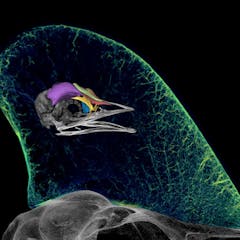
Articles sur X-ray
Affichage de 1 à 20 de 27 articles

Proton beam therapy is a precise form of radiation that can reduce the side-effects of cancer treatment. It is available around the world, but not in Canada.

Some countries no longer require you to remove your shoes when passing through security – but taking out your laptop is still mostly required.

A physicist explains how atoms arrange themselves into molecules – and how scientists are able to image these tiny bits of matter that make up everything around you.

X-ray scans are taken in hospitals worldwide – and an AI program has been taught to scan them for coronavirus.

Scientists have been using art to illuminate and share their research with the public for centuries. And art could be one way to bolster K-12 science education and scientific literacy in the public.

On Oct. 1, 1971, Godfrey Hounsfield’s invention took its first pictures of a human brain, using X-rays and an ingenious algorithm to identify a woman’s tumor from outside of her skull.

New study used X-rays of the teeth of early mammals’ to show they were more like cold blooded reptiles.

The landscape artist bravely left her aristocratic life behind to help save lives on the Italian front.

It turns out to be fairly complicated to figure out how electricity will flow through materials – a crucial question for designing new electronics and semiconductor materials.

Liquid minerals containing sulfur behave like a hot knife through butter – they’re so corrosive they can melt their way through solid rock.

An X-ray sensitive ink means future detectors could be printable, portable and flexible.

There are many different types of medical imaging and they all pick up different things.

If an undocumented migrant is a minor or an adult can have far-reaching implications. A forensic anthropologist explains why relying solely on dental X-rays to determine age doesn’t work.

New research uses pathology in dinosaur bones to look at predator-prey interactions in the fossil record.

The galaxies, stars and planets in our universe can look very different when you view them through equipment that sees beyond the visible light our eyes can see.

During World War I, Marie Curie left her lab behind, inventing a mobile X-ray unit that could travel to the battlefront and training 150 women to operate these ‘Little Curies.’

Studying mysterious neutron stars could uncover the secrets of exotic physics – and a way to navigate the stars.

Did your holiday gift list include radiation-shielding undies to protect your privates from cellphone radio waves? A radiation expert explains they’re unnecessary – your phone won’t affect your fertility.

Modern sabre-tooth mammals have their canines constantly on display. This allows them to seduce mates. But was sexual selection also an important phenomenon among our pre-mammalian ancestors?

It took cutting edge technology and a collaboration between the Australian Synchrotron and the CSIRO to reveal the mysterious hidden lady in Degas’s famous painting.
